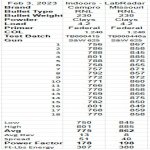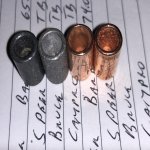Powder coated are faster then lead-lubed bullets. Plated and jacketed will always be slower with the same powder load. Felt recoil will be almost the same due to powder load.
To get the same velocity with plated you drop the powder by a bunch for lead bullets.
Look at Lyman reloading book and study the loading for lead to jacket.
To get the same velocity with plated you drop the powder by a bunch for lead bullets.
Look at Lyman reloading book and study the loading for lead to jacket.










































































